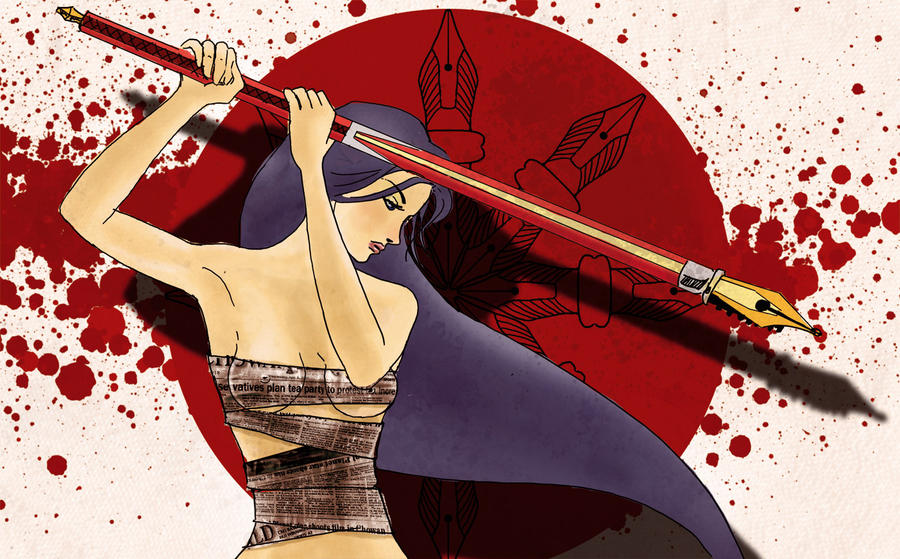Cutting Pages In A Book
We build our books
like we build our lives
one page upon the other
connected
Our histories set in the first chapters
our futures not yet readable
Ink stains of mysteries
laid upon our shirt sleeves
Use the double edged penknife
upon the uncut pages of this book
Open it up to create
your journal,
a confidant of memories.
Let the paper cut bleed words
upon this creamy, deckled paper
And if your pen is your excalibur,
then this tome is your stone.

Excalibur was king Arthur's sword. In Welsh it was known as Caledfwlch, in Cornish as Calesvol, in Breton as Kaledvoulc'h (all of which were compounds of "caled"/hard and "bwlch"/breach or cleft"), and in Latin as Caliburnus, as Geoffrey of Monmouth called it in ca. 1136, modified from the Medieval Latin "calibs"/ steel. It appeared in several early Welsh works, including the 11th-century prose tale "Culhwch and Olwen," which Lady Charlotte Guest included in "The Mabinogion" (1838-1845), which detailed the adventures of Arthur's cousin Culhwch. In another of the "Mabinogion" tales, the 13th-century "Breuddwyd Rhonabwy" (The Dream of Rhonabwy),
ReplyDeleteit was described as having "a design of two chimeras on the golden hilt; when the sword was unsheathed what was seen from the mouths of the two chimeras was like two flames of fire, so dreadful that it was not easy for anyone to look." Between 1136-1140 Geoffroy Gaimar translated various works into an Old French poem "L'Estoire des Engleis" (History of the English People) and called Arthur's sword Caliburc, which in later works other writers gradually evolved into Excalibur. In the late 12th century "Perceval ou le Conte du Graal" Chrétien de Troyes called it "the finest sword that there was, which sliced through iron as through wood." In many versions its blade was engraved with "Take me up" on one side and "Cast me away" on the other. When Arthur 1st drew it in battle to prove his right to rule, it blinded his enemies (like "30 torches" in Thomas Mallory's account). The sword became associated with the rightful sovereignty of Britain, but was usually regarded as not the same sword embedded in stone that the young Arthur withdrew. Geoffrey claimed that the sword was forged on the Insula Avalionis (Avalon). In Robert de Boron's "Roman du Graal" (ca. 1240-1250) the Damoisele del Lac (Lady of the Lake) gave it to Arthur early in his reign, after his original sword was damaged. The same author, however, in his "Merlin" (ca. 1195-1210), wrote that Arthur obtained his kingship by proving that he was the only person who could extract a sword from an anvil. In most accounts the "sword in the stone" and Excalibur were different weapons, but in "The Hoole Book of Kyng Arthur and of His Noble Knyghtes of The Rounde Table" (Le Morte d'Arthur", 1485) Malory explicitly conflated them as the same weapon. Excalibur's scabbard also had magical powers, including preventing its bearer from bleeding; Malory told that it was stolen and thrown into a lake by Arthur's evil 1/2 sister Morgan le Fay, thus leading to his death via her nephew Mordred (the bastard son of Arthur and her sister Morgause). In the 13th-century "Mort le roi Artu" the dying Arthur ordered Griflet, one of his 1st Knights of the Round Table and one of his chief advisors, to throw Excalibur into an enchanted lake, where it was caught and carried away by the Damoisele del Lac; when Malory retold the Arthur saga, following the account from the 14th century "Morte Arthur," Arthur's queen Guinevere was sentenced to die due to her adultery with Sir Lancelot, who, when he rescued her, killed Griflet, so Mallory had Griflet's cousin Bedivere perform the task of returning the sword to the Damoisele.